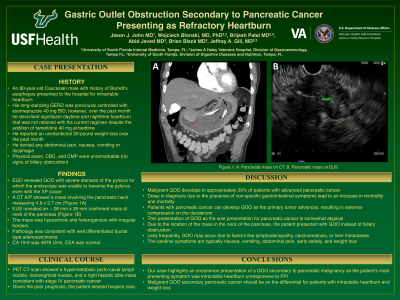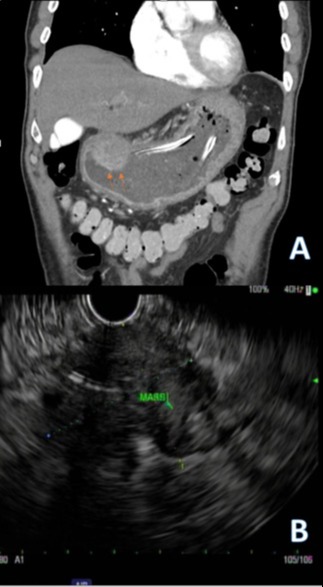Sunday Poster Session
Category: Biliary/Pancreas
P0074 - Gastric Outlet Obstruction Secondary to Pancreatic Cancer Presenting as Refractory Heartburn
Sunday, October 22, 2023
3:30 PM - 7:00 PM PT
Location: Exhibit Hall

Has Audio

Jason John, MD
USF Health
Tampa, FL
Presenting Author(s)
Jason John, MD1, Wojciech Blonski, MD, PhD2, Brijesh Patel, MD3, Abid Javed, MD1, Brian Black, MD4, Jeffrey Gill, MD1
1USF Health, Tampa, FL; 2James A. Haley Veteran's Hospital and USF Health, Tampa, FL; 3University of South Florida, Tampa, FL; 4University of South Florida Morsani College of Medicine, Tampa, FL
Introduction: Malignant gastric outlet obstruction (GOO) develops in approximately 20% of patients with advanced pancreatic cancer. Delay in diagnosis due to the presence of non-specific gastrointestinal symptoms lead to an increase in morbidity and mortality.
Case Description/Methods: An 80-year-old Caucasian male with history of Barrett’s esophagus presented to the hospital for intractable heartburn. His long-standing GERD was previously controlled with esomeprazole 40 mg BID, however, over the past month he described significant daytime and nighttime heartburn that was not relieved with his current regimen despite the addition of famotidine 40 mg at bedtime. He reported an unintentional 20-pound weight loss over the past month. He denied any abdominal pain, nausea, vomiting or dysphagia. Physical exam, CBC, and CMP were unremarkable (no signs of biliary obstruction). Esophagogastroduodenoscopy (EGD) revealed GOO with severe stenosis of the pylorus for which the endoscope was unable to traverse the pylorus even with the XP scope. A CT A/P showed a mass involving the pancreatic neck measuring 4.6 x 2.7 cm (Figure 1A). An endoscopic ultrasound (EUS) revealed an ~ 28 mm x 35 mm confirmed mass at neck of the pancreas (Figure 1B). The mass was hypoechoic and heterogenous with irregular borders. Pathology was consistent with well differentiated ductal type adenocarcinoma. CA 19-9 was 4976 U/ml, CEA was normal. PET CT scan showed a hypermetabolic porto-caval lymph nodule, rectosigmoid nodule, and a right hepatic lobe mass consistent with stage IV pancreatic cancer. Given the poor prognosis, the patient elected hospice care.
Discussion: Patients with pancreatic cancer can develop GOO as the primary tumor advances, resulting in external compression on the duodenum. This presentation of GOO as the sole presentation for pancreatic cancer is somewhat atypical. Due to the location of the mass in the neck of the pancreas, patient presented with GOO instead of biliary obstruction. Less frequently, GOO may occur due to factors like lymphadenopathy, carcinomatosis, or liver metastases. The cardinal symptoms are typically nausea, vomiting, abdominal pain, early satiety, and weight loss. Our case highlights an uncommon presentation of a GOO secondary to pancreatic malignancy as the patient’s main presenting symptom was intractable heartburn unresponsive to PPI. Malignant GOO secondary pancreatic cancer should be on the differential for patients with intractable heartburn and weight loss.

Disclosures:
Jason John, MD1, Wojciech Blonski, MD, PhD2, Brijesh Patel, MD3, Abid Javed, MD1, Brian Black, MD4, Jeffrey Gill, MD1. P0074 - Gastric Outlet Obstruction Secondary to Pancreatic Cancer Presenting as Refractory Heartburn, ACG 2023 Annual Scientific Meeting Abstracts. Vancouver, BC, Canada: American College of Gastroenterology.
1USF Health, Tampa, FL; 2James A. Haley Veteran's Hospital and USF Health, Tampa, FL; 3University of South Florida, Tampa, FL; 4University of South Florida Morsani College of Medicine, Tampa, FL
Introduction: Malignant gastric outlet obstruction (GOO) develops in approximately 20% of patients with advanced pancreatic cancer. Delay in diagnosis due to the presence of non-specific gastrointestinal symptoms lead to an increase in morbidity and mortality.
Case Description/Methods: An 80-year-old Caucasian male with history of Barrett’s esophagus presented to the hospital for intractable heartburn. His long-standing GERD was previously controlled with esomeprazole 40 mg BID, however, over the past month he described significant daytime and nighttime heartburn that was not relieved with his current regimen despite the addition of famotidine 40 mg at bedtime. He reported an unintentional 20-pound weight loss over the past month. He denied any abdominal pain, nausea, vomiting or dysphagia. Physical exam, CBC, and CMP were unremarkable (no signs of biliary obstruction). Esophagogastroduodenoscopy (EGD) revealed GOO with severe stenosis of the pylorus for which the endoscope was unable to traverse the pylorus even with the XP scope. A CT A/P showed a mass involving the pancreatic neck measuring 4.6 x 2.7 cm (Figure 1A). An endoscopic ultrasound (EUS) revealed an ~ 28 mm x 35 mm confirmed mass at neck of the pancreas (Figure 1B). The mass was hypoechoic and heterogenous with irregular borders. Pathology was consistent with well differentiated ductal type adenocarcinoma. CA 19-9 was 4976 U/ml, CEA was normal. PET CT scan showed a hypermetabolic porto-caval lymph nodule, rectosigmoid nodule, and a right hepatic lobe mass consistent with stage IV pancreatic cancer. Given the poor prognosis, the patient elected hospice care.
Discussion: Patients with pancreatic cancer can develop GOO as the primary tumor advances, resulting in external compression on the duodenum. This presentation of GOO as the sole presentation for pancreatic cancer is somewhat atypical. Due to the location of the mass in the neck of the pancreas, patient presented with GOO instead of biliary obstruction. Less frequently, GOO may occur due to factors like lymphadenopathy, carcinomatosis, or liver metastases. The cardinal symptoms are typically nausea, vomiting, abdominal pain, early satiety, and weight loss. Our case highlights an uncommon presentation of a GOO secondary to pancreatic malignancy as the patient’s main presenting symptom was intractable heartburn unresponsive to PPI. Malignant GOO secondary pancreatic cancer should be on the differential for patients with intractable heartburn and weight loss.

Figure: Figure 1: Pancreatic Mass, A: CT findings (red arrows), B: EUS findings (green arrows)
Disclosures:
Jason John indicated no relevant financial relationships.
Wojciech Blonski indicated no relevant financial relationships.
Brijesh Patel indicated no relevant financial relationships.
Abid Javed indicated no relevant financial relationships.
Brian Black indicated no relevant financial relationships.
Jeffrey Gill indicated no relevant financial relationships.
Jason John, MD1, Wojciech Blonski, MD, PhD2, Brijesh Patel, MD3, Abid Javed, MD1, Brian Black, MD4, Jeffrey Gill, MD1. P0074 - Gastric Outlet Obstruction Secondary to Pancreatic Cancer Presenting as Refractory Heartburn, ACG 2023 Annual Scientific Meeting Abstracts. Vancouver, BC, Canada: American College of Gastroenterology.
